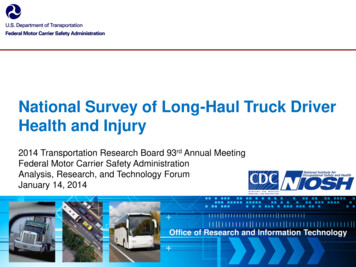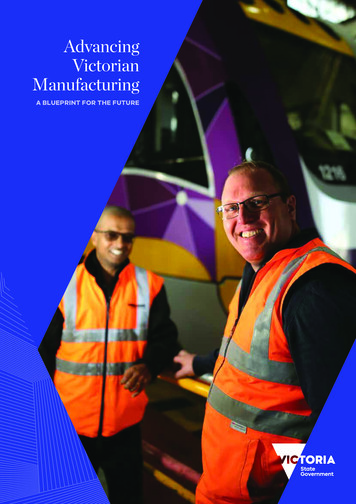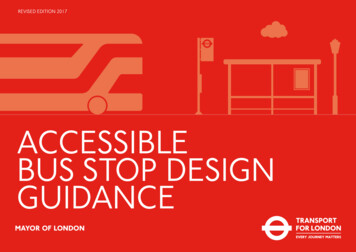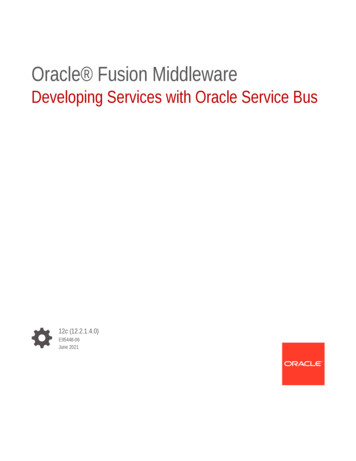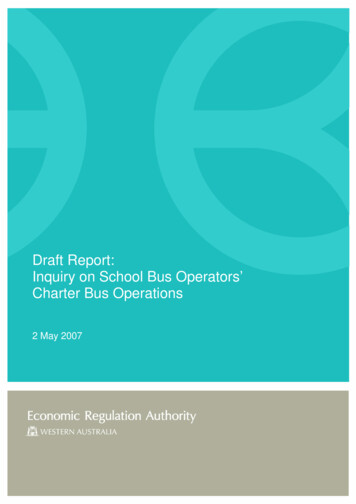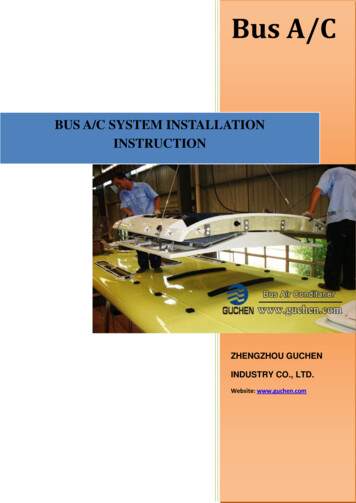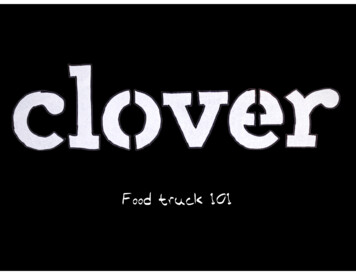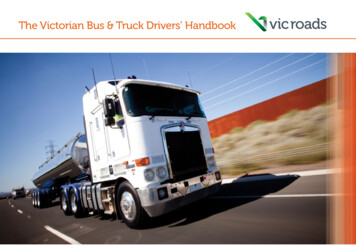
Transcription
The Victorian Bus & Truck Drivers’ Handbook
More informationPublication informationFor further information please phone 13 11 71or visit vicroads.vic.gov.auAuthorised and published by VicRoads60 Denmark Street, Kew, Victoria 3101Latest information on road lawsISBN 9789 0 7311 9165 9Road laws change from time to time. So, tests for the roadlaws will change as well. Check that you have the most recentedition of this book by visiting vicroads.vic.gov.au. If you are indoubt, check with any of the Customer Service Centres.CopyrightThis work is copyright. Apart from uses permitted under theCopyright Act 1968, no part may be reproduced, in wholeor in part, by any process without written permission fromVicRoads. Permission is hereby given to copy and distributeparts of this work (within the limitations specified in theCopyright Act) for the purposes of bona fide research andinstruction, provided such copies are made available free ofcharge.First published July 1988Reprinted with amendments October 2019 Crown CopyrightRoads Corporation, Victoria, Australia.
Table of contentsIntroduction – What this handbook is about and how to use it2Chapter 1– Driver licences4Chapter 2– The Heavy Vehicle National Law (HVNL)16Chapter 3– Fatigue management and National Driver Work Diary22Chapter 4– Ready to drive: driver health and safety38Chapter 5– Vehicle checks44Chapter 6– Controlling your vehicle52Chapter 7– Driving on the road: planning and observing60Chapter 8– Communicating with other drivers and how to judge safe speed76Chapter 9– Vehicle emergencies84Chapter 10– Crashes94Chapter 11– Dimensions and load limits96Chapter 12– Heavy vehicle signs104Chapter 13– Coupling and uncoupling trailers110Chapter 14– Skills required to drive a bus116Words that heavy vehicle drivers need to know120Index1243
Introduction - What this handbook is about and how to use itThis chapter includes:»» Why you should readthis handbook»» Your legal rightsand obligations»» How to use this handbook»» Some technical words youshould know»» Why there is a national systemof driver licence classesWhy you should read this handbookThis handbook tells you about some of the main legal requirements for driversof heavy vehicles in Victoria. It is intended as a guide only and does not setout in full all the requirements of the law.Before you read this handbook you need a general knowledge of ourroad laws. Road law information is contained in the Road to Solo Drivinghandbook available at VicRoads Customer Service Centres, RACV officesand some newsagents.The Road to Solo Driving handbook can be viewed from the VicRoadswebsite at vicroads.vic.gov.auYour legal rights and obligationsThe legal requirements described in this handbook will change from time totime. To understand all your legal rights and obligations, you should refer tothe Road Safety Act 1986 (Victoria) and related Road Safety Regulations, aswell as the Transport Act 1983 (Victoria) and the Heavy Vehicle National Law(Victoria) and associated national Heavy Vehicle Regulations.More information on the Heavy Vehicle National Law (HVNL) and associatedRegulations can be viewed at nvhr.gov.au.4
This handbook will help you to understand some of the specialrules and regulations that apply to driving a heavy vehicle.If there is something specific you need to know about, you canlook it up in the index at the back of this handbook (page 124).At the start of each chapter, there is an information box tellingyou what is in the chapter.At the end of each chapter is a section called Test YourselfQuestions. These help you check if you’ve understoodimportant material in the chapter.The language of heavy vehiclesThere are many words that have a technical or specialmeaning for heavy vehicles. You’ll find them used frequentlythroughout this handbook.Check the list at page 120 for a description of theseindustry-specific terms.Why there is a national system of driverlicence classesAll states and territories in Australia have a uniform driverlicence system. The licence classes are:C CarHR Heavy RigidLR Light RigidHC Heavy CombinationMR Medium RigidMC Multi-CombinationIntroductionHow to use this handbookEach state and territory in Australia has the same licence andvehicle categories.What this means for you is that you can use VicRoads toget a licence or register a heavy vehicle, which allows youto drive in any state and territory, with the same vehicleand the same licence.5
Chapter 1 – Driver licencesThis chapter includes:»» Driver licences»» N ational heavy vehiclelicence classification»» Penalties for unlicensed driving»» Learning to drive a heavy vehicle»» W hich parts of this handbook youneed to know for the assessments»» Accredited providers»» S pecial needs of heavyvehicle drivers»» Medical eligibility»» V ehicles for which you needspecial permits to drive»» Carrying dangerous goods»» Mobile equipment»» V ehicles and load requirementsfor assessment»» Assessment in a loaded vehicle»» Cabin cameras»» Test yourself questions6Driver licencesAll states and territories have implemented common rules and categoriesfor heavy vehicles. The National Heavy Vehicle licence scheme includes allvehicles with a Gross Vehicle Mass (GVM) above 4.5 tonnes.Driver licences are issued in the categories shown in the diagram on the nextpage. If you have a licence, you may drive any class of vehicle within or aboveyour licence category as shown in the diagram.Check what you can drive with each category of licence. The letters written inbrackets are the code for the licence class. This code will be printed on yournew licence in the square labeled Licence Type.The HVNL does not affect the way you go about getting your driver’s licence.Drivers can still do some of their heavy vehicle business at VicRoads CustomerService Centres, including applying for and renewing your driver licencesand purchasing the new National Driver Work Diary.
CAR (C)A vehicle of 4.5 tonnes GVM orless, seating up to 12 people.You are eligible for a carlicence at 18 years of age.LIGHT RIGID (LR)A vehicle greater than 4.5 tonnes but nogreater than 8 tonnes GVM or which seatsmore than 12 people (including driver).You are eligible for a LIGHTRIGID licence after holdingan Australian car licencefor 1 year.MEDIUM RIGID (MR)Any 2 axle rigid vehicle greater than8 tonnes GVM.You are eligible for aMEDIUM RIGID licence afterholding an Australian carlicence for 1 year.HEAVY RIGID (HR)A vehicle 8 tonnes GVM and above,with 3 or more axles.You are eligible for a HEAVYRIGID licence after holdingan Australian car licencefor 2 years.HEAVY COMBINATION (HC)(a) A prime mover to which is attached asingle semi-trailer that has a GVM morethan 9 tonnes plus any unladen converterdolly; or (b) A rigid motor vehicle to which isattached a trailer that has a GVM more than9 tonnes plus any unladen converter dolly.MULTI COMBINATION (MC)A Heavy Combination vehicle with morethan one trailer.Chapter 1 - Driver licencesNational heavy vehicle licence categoriesYou are eligible for a HEAVY COMBINATIONlicence after at least 1 year of holding eithera MEDIUM RIGID or HEAVY RIGID vehiclelicence. You must also successfully completean approved training course.You are eligible for a MULTI COMBINATIONlicence after 1 year of holding a HEAVYCOMBINATION or a HEAVY RIGID vehiclelicence. You must also successfully completean approved training course.Note: The content and duration of the course will depend onthe category of licence held.7
Learning to drive a heavy vehicleIt is an offence to drive a vehicle in a category for which youare not licensed. It is also an offence to employ or allowsomeone who does not hold the right category of licence todrive that vehicle.If you have a crash while driving a vehicle you are notlicensed to drive, the Transport Accident Commission maynot pay all your compensation claim.Until you get your heavy vehicle licence you may drive aheavy vehicle only if you are accompanied by a person whoholds a valid licence for the type of vehicle you are driving.You must display Driver Under Instruction plates at thefront and rear of the vehicle.While learning to drive a heavy vehicle, you must have a zeroBlood Alcohol Concentration (BAC) at all times.Chapter 1 - Driver Licences8Penalties for unlicensed driving
To obtain a heavy vehicle licence, Victorian applicants needto successfully complete a theory assessment, an off-roadpractical assessment and an on-road practical drivingassessment. The off-road practical assessment includesactivities such as load securing, pre-operational checkand cabin drill.Refer to the list below for topics your instructor should coverbefore your theory and practical assessments. The on-roadpractical driving assessment has been designed to closelyassess the driving skill of heavy vehicle licence applicants.This handbook provides information on what is expected ofa successful licence applicant. The practical assessment willassess your skill in:»» Pre-operational checkYou should read all chapters of this handbook to prepare forthe assessments.»» Cabin drillThe theory assessment that you must pass to get a heavyvehicle licence is based on the material in this handbook.»» SteeringMulti Combination (MC) and Heavy Combination (HC)applicants must pass a theory assessment based oninformation presented during the training course.The theory assessment must be passed once for the rigidvehicle requirements and once for the articulated vehiclerequirements. The theory assessment must be passed beforethe applicant is permitted to commence the off-road practicalassessment or the on-road practical driving assessment.A handbook cannot provide driving experience, so heavyvehicle licence applicants need on-road and off-road drivingtraining from experienced heavy vehicle drivers.Chapter 1 - Driver licencesWhich parts of this handbook you need toknow for the assessments»» Start, move off, shut down and secure»» Gears»» Manages brakes»» Manages accelerator»» Create and maintain Crash Avoidance Space»» Protect Crash Avoidance Space»» Road rules and directions»» Reverse»» Hill stop/start»» Load securing»» Coupling/uncoupling (articulated vehicles only)»» Bus stop procedure (bus only)9
Special needs of heavy vehicle driversIn Victoria accredited providers conduct all heavy vehiclelicence tests on behalf of VicRoads. Visit the VicRoadswebsite vicroads.vic.gov.au for a list of organisations thatare accredited by VicRoads to conduct heavy vehicle trainingand testing.If you pass your licence assessment with an accredited provider,you will be issued with a VicRoads Certificate of Competence.You will need to take the certificate to a VicRoads CustomerService Centre to get your licence.Heavy vehicle drivers are professionals who spend most oftheir working hours on the road.Heavy vehicle drivers usually drive further than car driversand drive for longer hours than other drivers. So there is agreater chance of them being involved in crashes.Heavy vehicles accelerate more slowly than passenger carsand take longer to stop, so more judgement and driving skillis required to drive heavy vehicles. Crashes which involveheavy vehicles are more likely to cause severe injury andgreater damage than crashes which involve only cars.Car drivers can make heavy vehicle driving more difficultwhen they do not know about the slower acceleration,braking and space needed by heavy vehicles.The community expects professional drivers to have a higherstandard of knowledge and skill.Chapter 1 - Driver Licences10Accredited providers
There is a wide range of medical, hearing and eyesightconditions which will prevent the issue of a heavyvehicle licence.Some common conditions that may affect the issue of aheavy vehicle licence include:»» visual defects, including loss of vision in one eye»» hearing defects»» angina, heart disease/surgery/hypertension, havinga pacemaker»» some psychiatric disordersHaving these conditions does not necessarily prevent theissue of a licence but will require careful evaluation. In somecases a restricted licence may be considered.Drivers are required by law to notify VicRoads of anyserious, permanent or long term illness, disability, medicalcondition or injury (or the effects of treatment for any ofthose things) that may affect their fitness to drive.In addition to the appropriate licence, you must obtain aDriver Accreditation to drive a vehicle carrying passengersfor hire and reward. Strict eyesight requirements applyto Driver Accreditation applicants. See page 8 for DriverAccreditation enquiries.Chapter 1 - Driver licencesMedical eligibility»» epilepsy»» diabetes»» sleep apnoea»» head injuries, dementia, stroke»» Parkinson’s disease, multiple sclerosis»» physical disabilities/partial or complete loss of limbs.If you are concerned that you may not be eligible, you shouldspeak to your doctor or contact VicRoads on 13 11 71 andask to speak to the Medical Review area.11
Special note1. If you are tested in a vehicle fitted withsynchromesh gears, a condition on your licencewill apply. The letter “B” will show on your licence. To have the condition removed, you will need to beretested in a vehicle with non-synchromesh gears.2. If you have a manual car licence and you are testedin a heavy vehicle with an automatic transmission,you will be restricted to driving heavy vehicles withsynchromesh gears. The letter “B” will show onyour licence.3. If you have an automatic car licence and you aretested in an automatic heavy vehicle, you willbe restricted to automatic vehicles during yourprobationary period. After your probationary period, your licence willbe converted to manual for car only, but thecondition limiting you to synchromesh gears forheavy vehicles will continue to apply unless you areretested. The letter “B” will show on your licence.12Vehicles for which you need special permitsto driveDriver Accreditation must be held by drivers of:»»»»»»»»passenger busesprivate omnibusesspecial purpose vehiclesrestricted hire vehicles.Driver AccreditationHolding a vehicle licence does not automatically entitle you todrive passenger vehicles. You will normally only be issued acertificate if you have:»» a good driving record»» no criminal convictions, including sex, alcohol or drugoffences»» no medical condition which may affect the skillsneeded to drive a commercial vehicle.Enquiries about Driver Accreditation should be made to theVictorian Taxi Directorate on 1800 638 802 (Toll free). Ask forDriver Accreditation.
Vehicle and load requirements for assessmentTo transport bulk dangerous goods on Victorian roads adriver must:Vehicle requirements»» be registered with the Victorian WorkCover Authority»» have a current permit issued by the VictorianWorkCover Authority»» carry the permit at all times when driving a vehiclecarrying bulk dangerous goods»» have a valid driver licence for the category of vehiclebeing driven.If you are not a Victorian resident, you must have a permitto carry that class of goods and a valid driver licence for thevehicle you are driving issued by your own state or territory.You must carry the permit and driver licence with you atall times.Mobile equipmentOperator certificates must be held by drivers who operate:»» mobile cranes»» self-loading cranes»» fork-lifts»» concrete pumps with booms.Enquiries about Dangerous Goods and Mobile Equipmentcan be made to the Victorian WorkCover Authority on(03) 9641 1555.The vehicle used for the off-road and on-road practicalassessments must be the correct type and configuration forthe class of licence for which the applicant is applying andapproved by VicRoads as detailed below. It must be registered,roadworthy and comprehensively insured. Any vehicle fitted witha manual gear box, but having its gears changed by robotic orcomputerised systems, is regarded as an automatic vehicle.Chapter 1 - Driver licencesCarrying dangerous goodsMulti Combination (MC)»» A Heavy Combination vehicle with more than onetrailer. The vehicle must be B-Double rated and haveall the pertinent documentation, permits etc. Thecombination must be at least 22 metres in length, inB-double configuration.»» The minimum vehicle type for an MC is a three axleprime mover with an A and B trailer each withbogie axles.Heavy Combination (HC)»» A vehicle consisting of a prime mover and a semi‑trailer.The prime mover must have a minimum of three axlesand the semi-trailer a minimum of two axles. The vehiclemust have a Gross Combination Mass (GCM) rating ofat least 39 tonnes; or»» A Heavy Rigid vehicle which is towing a trailer.The trailer must have at least two axles and a GVMof 12 tonnes or more.13
Heavy Rigid (HR)»» A rigid vehicle, not being an unladen prime mover, witha minimum of three axles and a minimum 15 tonnesGVM; or»» A modified three axle prime mover with a certifieddetachable tray (with the capacity to carry 75% of itsspecified GVM) with a minimum GVM of 15 tonnes andholds dual registration (HC and HR), or»» A three axle articulated bus*; or»» A three axle bus* above 15 tonnes GVM.Medium Rigid (MR)»» A two axle rigid truck, not being a prime mover, above8 tonnes GVM; or»» A two axle bus* above 8 tonnes GVM.Light Rigid (LR)»» A rigid truck above 4.5 tonnes GVM but less than orequal to 8 tonnes GVM; or»» A rigid bus* with less than or equal to 8 tonnes GVM orseats more than 12 adults, including the driver.Vehicle restrictionsMost vehicles will be suitable for on-road tests, howeversome have restrictions placed on them as follows and cannotbe used for licence testing:»» Armoured vehicles»» Dual control vehicles»» Vehicles displaying trade plates»» Vehicles carrying a placard of dangerous goods»» Special Purpose Vehicles (except emergency servicevehicles)Cranes, specialised road working vehicles and farmmachinery»» Federal Interstate Registered vehiclesThese vehicles may only be used if a special permithas been supplied by the relevant transport authority»» Livestock transport vehiclesIf the load is livestock»» * Buses, coaches and motor homesBuses or motor homes will only be permitted tobe used as an assessment vehicle for light rigidassessments only as long as the vehicle fits thespecification for a light rigid vehicle (see above).14For all other vehicle categories, buses, coaches andmotor homes will only be approved for use as anassessment vehicle in special circumstances asdetermined by VicRoads.
Assessment in a loaded vehicleTo check an applicant’s ability to drive a loaded heavyvehicle some tasks, specifically the on-road practical drivingassessment tasks, require the vehicle to be loaded. All loadsmust be positioned and secured in compliance with the NationalTransport Commission’s guidelines, available at ntc.gov.auCabin camerasIt is a requirement that vehicles are equipped with cabintechnology approved by VicRoads. The on-road practicaldriving assessment will need to be recorded using audio,video and GPS technology. Both the applicant and assessorwill be recorded during the assessment.Chapter 1 - Driver licencesIn such circumstances these vehicles are exempt fromcarrying a load. Assessments must not be conducted inthese vehicles when carrying passengers, with the exceptionof VicRoads auditors.The loaded vehicle must have a mass which is at least 75%of the maximum mass allowable for the vehicle to be drivenon public roads. This is at least 75% of either the legal masslimit, Gross Vehicle Mass (GVM) for rigid vehicles or GrossCombination Mass (GCM), for articulated or heavy trailercombinations. The vehicle must be able to maintain adequateroad speed. See Chapter 11 for details on loads.If the applicant is being assessed in their own vehicle, it isthe applicant’s responsibility to check the load requirementsbeforehand and be prepared to provide documentedevidence such as a weighbridge ticket that was issued withinthe past 24 hours. The accredited heavy vehicle assessmentprovider must ensure that photographic evidence of theload in the applicant’s vehicle is captured and kept on file forauditing purposes.15
Notes16
(Answers to test yourself questions are upside down at thebottom of this page)1If you do not hold a heavy vehicle licence you maydrive a heavy vehicle only ifA. you are accompanied by a person who has a licencefor that type of vehicle and you display Driver UnderInstruction platesB. you display L plates and do not drive on highwaysChapter 1 - Driver licencesTest yourself questionsC. you drive in daylight hours only and are accompaniedby a person who has a licence for that type of vehicleIf you have a Medium Rigid (MR) licence, you mayalso drive aA. Heavy Combination (HC) vehicleB. Heavy Rigid (HR) vehicleC. Light Rigid (LR) vehicleA nswers 1A 2C217
Chapter 2 – The Heavy Vehicle National Law (HVNL)This chapter includes:»» Law enforcement»» Speed limits»» Seatbelts»» Portable warning triangles»» Railway crossings»» Requirements to weighyour vehicle»» Parking»» Chain of responsibility»» Test yourself questionsThe Heavy Vehicle National Law (HVNL) and Regulations have commencedin Victoria.Queensland, New South Wales, South Australia, Australian Capital Territoryand Tasmania have introduced the law as well. The Northern Territory andWestern Australia have not commenced the HVNL at this time.For the first time, heavy vehicle drivers, operators and others in the supplychain in those states and territories where the law has commenced will beworking to the same rules, regardless of where they operate.The National Heavy Vehicle Regulator (NHVR) will administer the new law forheavy vehicles over 4.5 tonnes gross vehicle mass.In addition to this law, drivers of heavy vehicles must comply with all otherroad laws. A summary of these road laws can be found in the Road to SoloDriving handbook, which is available from VicRoads Customer ServiceCentres, RACV offices and some newsagents.You should have a copy of it to read together with this handbook.Law enforcementVicRoads Transport Safety Services (TSS) and Victoria Police aim to improveroad safety for all road users and protect roads and bridges from damage byensuring that heavy vehicles comply with the road laws.Compliance and enforcement of the Heavy Vehicle National Law is a keyfunction of TSS officers. The law authorises them to intercept offending roadusers. While their focus is on heavy vehicle regulations, TSS officers can alsoexercise judgment in issuing fines for offences by any road user.VicRoads TSS officers will continue to enforce heavy vehicle offences underthe HVNL on behalf of the National Heavy Vehicle Regulator. Legal and courtprocesses will largely remain as they are.To enforce the HVNL, VicRoads TSS officers use both marked and unmarkedvehicles with magenta flashing lights.18
»» the mass and dimensions of your vehicle and its loadIt is an offence for any heavy vehicle to travel faster than100 km/h anywhere in Victoria.If any tyre on a vehicle is not a pneumatic tyre, the maximumspeed for the vehicle on any road is 25 km/h (a pneumatictyre is one which is filled with air).»» the condition of your vehicle»» your work diary, any relevant paperwork(eg access permit or accreditation) and licence details.It is an offence not to stop when asked or signaled to do soby a VicRoads TSS officer or Police officer.You must also pull into a weighbridge when directed by Policeor TSS officers or when signs direct you to do so.Speed limitsAll heavy vehicles with pneumatic tyres must travel at speedsno greater than the speed displayed on a speed limit sign aswell as complying with the following conditions:»» 40 km/h in a local traffic zone signed 40 km/h»» 50 km/h in a built-up area not otherwise signedWarning noteThe legal speed limit may not always be the safe speedfor a heavy vehicle because of the vehicle’s differenthandling, higher centre of gravity and performance.Drivers should always travel at a speed which is safe forthe conditions.Chapter 2 – The Heavy Vehicle National Law (HVNL)Local councils may also enforce parking and load limits withintheir boundaries.You must stop when you are signaled to do so by a Policeofficer or a VicRoads TSS officer. They may check:»» 100 km/h in a 100 km/h zone»» 100 km/h in a 110 km/h zone.19
SeatbeltsIn Victoria, drivers of heavy vehicles must wear a properlyadjusted and fastened seatbelt where one is fitted, or isrequired by law to be fitted to the vehicle.Passengers in trucks are also required to wear seatbelts.Seatbelts must not be removed if already fitted. All vehiclesmanufactured after 1 July 1977 are required to have seatbeltsfitted.As part of managing fatigue there is an exemption from wearingseatbelts for two-up drivers in sleeping compartments.Portable warning trianglesIf you drive a heavy vehicle with a Gross Vehicle Mass (GVM)over 12 tonnes, you must carry three approved portablewarning triangles in your vehicle at all times.If you have to stop your vehicle or if any part of your load fallsonto the road (including the shoulder), three portable warningtriangles must be placed on the road.On roads with a speed limit of 80km/h or more, if thevehicle is not visible for 300 metres in all directions:»» one triangle must be placed 200-250 metres behindthe vehicle or fallen load,»» one triangle must be placed 200-250 metres in frontof the vehicle or fallen load, and»» one triangle must be placed by the side of the vehicleor fallen load.20On roads with a speed limit of less than 80km/h, if thevehicle is not visible for 200 metres in all directions:»» one triangle must be placed 50-150 metres behindthe vehicle or fallen load,»» one triangle must be placed 50-150 metres in frontof the vehicle or fallen load, and»» one triangle must be placed by the side of the vehicleor fallen load.If the road is a one-way road or divided road (this does notinclude a road with a painted median), three triangles are stillneeded but there is no requirement to place a triangle in frontof the vehicle. This triangle should instead be placed betweenthe vehicle or fallen load and the triangle behind the vehicle.Nine 38mmbuttonsequally spacedWarning triangles must comply with the Australian Standard AS 3790
Requirements to weigh your vehicleIf your vehicle is less than 2.2 metres wide, you must useparking lights, unless there is street lighting and your vehicleis visible for 200 metres in all directionsIt is an offence to disobey traffic signs or hand signalsinstructing you to enter a weighbridge. It is also an offence torefuse to allow your vehicle to be weighed. You can be fined.Railway crossingsIf you are the driver of a bus that seats more than 12 adults(including the driver) approaching an uncontrolled railwaylevel crossing (without gates, booms, barriers, or twin redlights) you must:»» stop the bus so that the nearest part of the bus is notless than 3 metres and not more than 12 metres fromthe nearest rail of the railway»» satisfy yourself that there is no train or light rail vehicleon the track»» once reaching the crossing, proceed across in amanner which avoids the need to change gears untilthe crossing has been completely cleared»» leave the crossing as soon as you can do so safely.Special rules apply for vehicles transporting dangerousgoods at railway level crossings. Check these rules with theVictorian WorkCover Authority (see page 11 for details).Drivers must stop to allow their vehicles to be weighed andchecked when signalled to do so by Police or a VicRoadsTransport Safety Services (TSS) officer.Vehicles can be weighed at weighbridge locations or byportable equipment carried by VicRoads TSS officers.(See Chapter 11, “Dimensions and Load Limits” for weight limits)ParkingAny timeUnless a parking sign says that long vehicles are allowed topark in an area, you must not park in a built-up area for morethan one hour if your vehicle has a GVM over 4.5 tonnes or is7.5 metres long or longer, unless permitted by the local Council,or if you are engaged in dropping off or picking up goods.If any parking sign limits parking to less than one hour,you must obey that sign.You must always be careful and try to park as far awayfrom the stream of traffic as possible.Chapter 2 – The Heavy Vehicle National Law (HVNL)If your vehicle is wider than 2.2 metres and you stop on aroad or the shoulder of a road at night, you must have allrequired clearance and side marker lights operating andclearly visible for at least 200 metres in all directions.21
What is the chain of responsibility?The chain of responsibility means that anybody – not justthe driver – who has control in a transport operation can beheld responsible for breaches of road laws and may be madelegally liable.In other words, if you use road transport as part of yourbusiness, you share responsibility for ensuring breaches ofroad laws do not occur.So, if a breach of road transport law occurs due to youraction, inaction or demands, you may be legally accountable.Put simply this means:Control responsibility legal liability.22
Test yourself questions(Answers to test yourself questions are upside downat the bottom of this page)1. Drivers of heavy vehiclesA. do not have to wear seatbeltsB. must wear seatbelts if travelling more than 80 kmsC. are required by law to wear seatbelts when fitted.2. When driving a bus at a railway level crossingyou must stop the busA. at the nearest railB. between 3-12 metres from the nearest railC. between 10-20 metres from the nearest rail.Chapter 2 – The Heavy Vehicle National Law (HVNL)ANSWERS 1C 2BNotes23
Chapter 3 - Fatigue management and National Driver Work DiaryThis chapter includes:»» Fatigue management»» What is a work diary for?»» What is a fatigue-regulated heavy vehicle?»» What do I record in the work diary?»» Hours of driving»» How do I record information in a work diary?»» Work and rest hours»» What is a base?»» What is work time?»» How long must I carry work diary records?»» What is local work?»» What if I’m working under a two-up arrangement?»»
3 Introduction - What this handbook is about and how to use it 2 Chapter 1 - Driver licences 4 Chapter 2 - The Heavy Vehicle National Law (HVNL) 16 Chapter 3 - Fatigue management and National Driver Work Diary 22 Chapter 4 - Ready to drive: driver health and safety 38 Chapter 5 - Vehicle checks 44 Chapter 6 - Controlling your vehicle 52



